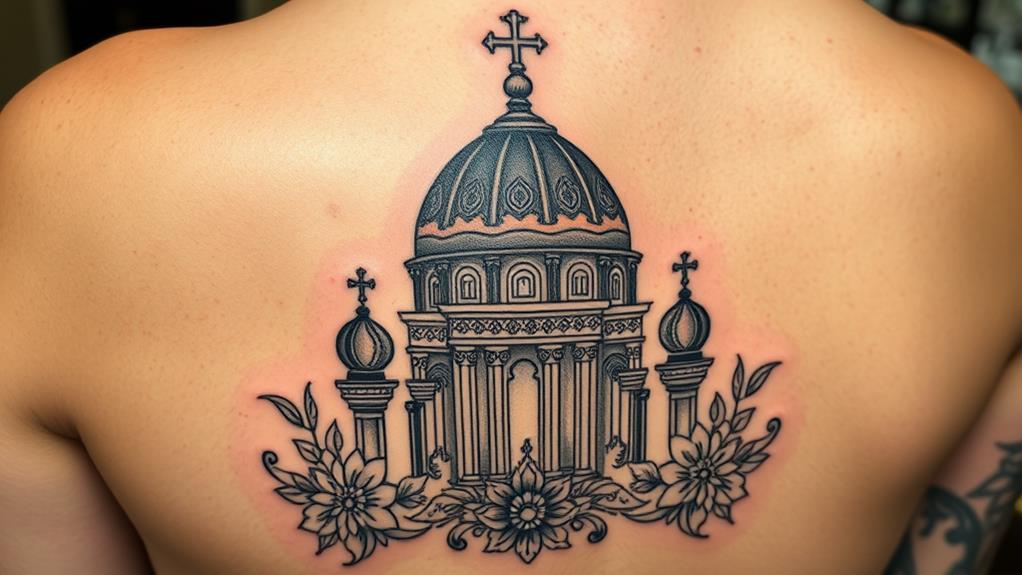I find Orthodox Church tattoos to be profound expressions of faith, marrying sacred architectural elements with personal spirituality. The designs often feature iconic shapes like domes and crosses, each carrying deep significance that connects wearers to their heritage. These tattoos not only reflect a commitment to religious beliefs but also serve as visual narratives of one's spiritual journey. They challenge common perceptions of body art, framing it instead as a medium for spiritual connection. Exploring the meaning behind these tattoos reveals layers of tradition and culture, inviting a deeper understanding of their significance in our lives.
Importance of Sacred Symbols

Sacred symbols serve as powerful visual representations of faith, offering a profound connection to the beliefs and traditions of the Orthodox Church.
As I explore these symbols, I realize they encapsulate complex theological concepts and historical narratives that resonate deeply with practitioners. Each symbol, from the cross to the icons, carries layers of meaning that reflect the church's teachings, the lives of saints, and the divine mysteries.
In my observations, these symbols not only serve as visual aids for worship but also as personal reminders of one's spiritual journey.
They can invoke a sense of belonging to a larger community and tradition, reinforcing one's identity as a believer. The intricate designs of these symbols often invite contemplation, prompting me to reflect on the core tenets of my faith.
Furthermore, as I consider the cultural significance of these symbols, it becomes evident that they bridge the gap between the sacred and the secular.
They can be found in various forms, from church architecture to personal tattoos, demonstrating their adaptability and enduring relevance. Ultimately, sacred symbols are essential in expressing and preserving the rich spiritual heritage of the Orthodox Church, influencing both communal and individual expressions of faith.
Popular Orthodox Architecture Elements
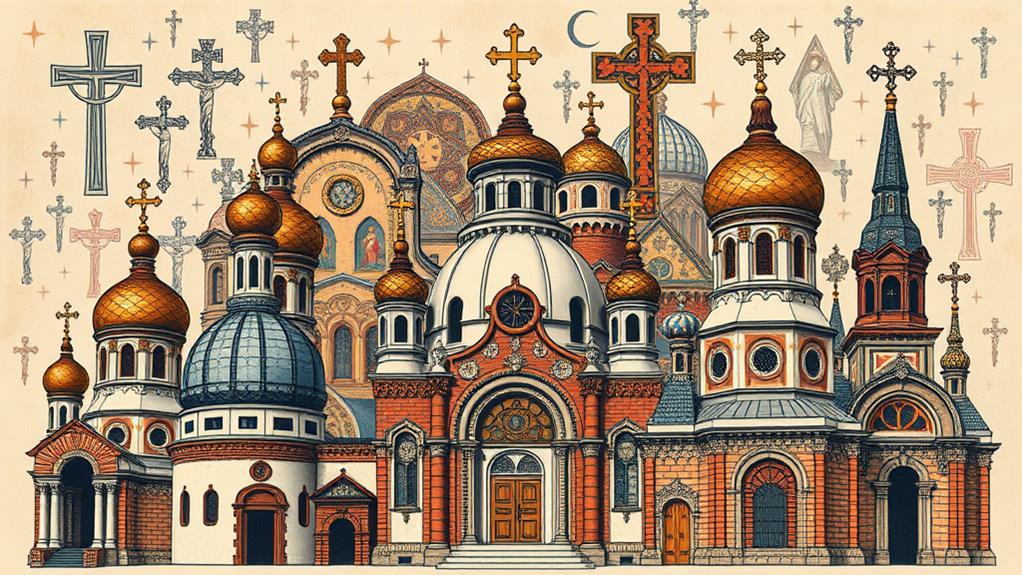
As I reflect on the profound significance of sacred symbols in Orthodox worship, I can't help but notice how these elements manifest in the architecture of Orthodox churches.
The design often features a cruciform layout, symbolizing the cross and the centrality of Christ in worship. This layout isn't merely functional; it embodies theological concepts and community gathering.
The dome, a hallmark of Orthodox architecture, represents the heavens and serves as a reminder of divine presence. Its elevation invites the congregation to look upward, fostering a sense of transcendence.
I find the use of frescoes and mosaics particularly striking, as they visually narrate biblical stories and saints' lives, thereby educating worshippers and enhancing their spiritual experience.
Additionally, the incorporation of iconostasis, a screen adorned with icons, serves as a bridge between the laity and the sacred. This element not only delineates space but also emphasizes the importance of icons in Orthodox spirituality.
In observing these architectural features, I see how they converge to create a sacred atmosphere, intertwining faith, art, and community in a harmonious expression of Orthodox identity.
Meaning Behind Tattoo Designs
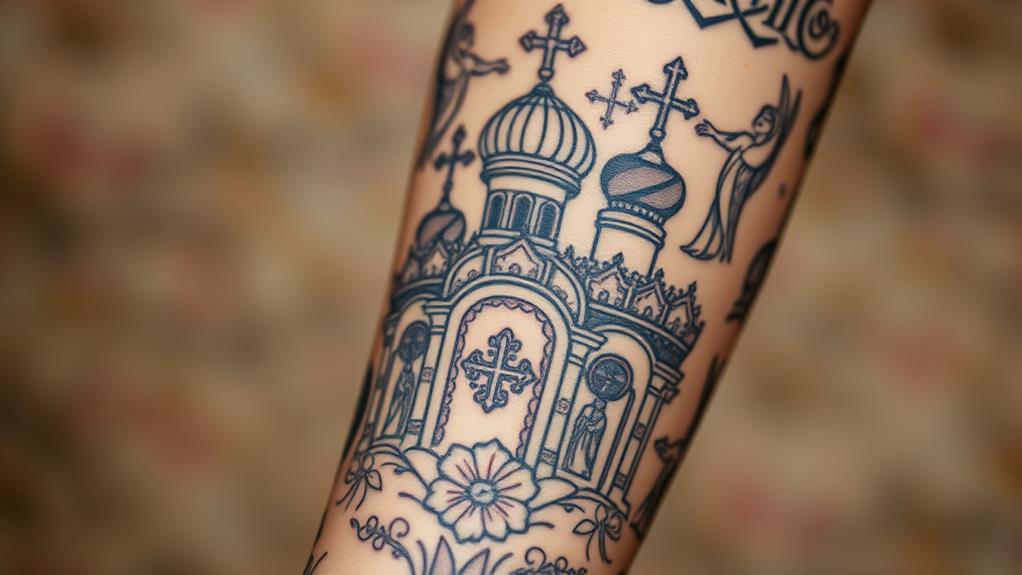
Exploring the intricate world of tattoo designs reveals a depth of meaning that often transcends mere aesthetics.
As I plunge into the symbolism embedded within Orthodox church tattoos, I discover that each design serves as a narrative, reflecting personal beliefs and spiritual journeys. For instance, a tattoo of a dome may symbolize divine connection, representing the heavens and the sacred within the earthly domain.
I also notice that the use of biblical figures or saints in these tattoos often conveys a desire for protection and guidance.
These images aren't merely decorative; they embody the wearer's faith and commitment to their spiritual path. The choice of color and placement further adds layers of significance. A vibrant blue might evoke the tranquility of the divine, while a tattoo on the wrist could signify constant reminders of faith in daily life.
Through this exploration, I realize that Orthodox church tattoos function as a form of visual theology, allowing individuals to express their spirituality in a deeply personal manner.
Each tattoo becomes an affidavit to one's beliefs, revealing how sacred architecture can transcend physical structures to inhabit the very skin of those who cherish it.
Historical Context of Tattooing

The practice of tattooing has a rich and varied history that intersects with cultural, religious, and personal identities.
I find it fascinating to explore how ancient civilizations used tattoos as markers of status, rites of passage, or expressions of belief. In many Indigenous cultures, tattoos often signify spiritual significance or connection to ancestry, serving as a visual narrative of one's life story.
Historically, the Greeks and Romans viewed tattoos in a different light, often associating them with barbarism.
However, many Christian communities, particularly in Eastern Orthodoxy, revered the act of tattooing as a form of devotion. This duality in perception showcases how tattoos can embody both stigma and sanctity, depending on the cultural lens through which they're viewed.
Moreover, in the 20th century, tattooing evolved into a form of personal expression, particularly within counter-cultures.
I observe that this shift reflects broader societal changes, where individual identity takes precedence over communal traditions. As I plunge deeper into the historical context of tattooing, it becomes clear that these inked designs carry profound meanings that resonate across time and space, shaping our understanding of identity and belonging.
Choosing the Right Artist
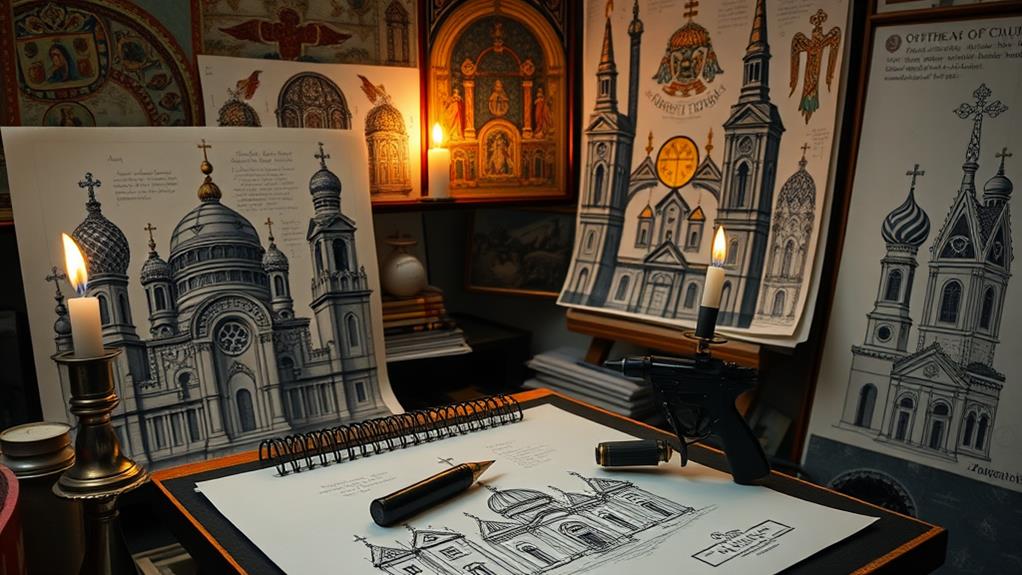
Finding the right tattoo artist is crucial to ensuring that the final piece aligns with one's vision and values, particularly within the context of Orthodox Church tattoos.
This choice goes beyond mere aesthetics; it encompasses an understanding of the sacred symbolism inherent in these designs.
I've learned that a qualified artist shouldn't only possess technical skill but also a sensitivity to the religious significance of the imagery.
When evaluating potential artists, I prioritize their portfolio, looking for experience with religious or architectural themes.
The complexity of Orthodox designs often requires a nuanced approach to line work and shading, which only a skilled artist can provide.
Additionally, I engage in conversations with them about their understanding of Orthodox symbolism.
A knowledgeable artist can discuss the meanings behind various elements, ensuring they can translate my vision accurately.
Moreover, I consider their environment—cleanliness and professionalism are non-negotiable.
An artist's studio should reflect their commitment to the craft, as this indirectly influences the quality of the work.
Ultimately, I recognize that choosing the right artist isn't just about the end product; it's about creating a piece that resonates deeply with my spiritual beliefs and personal narrative.
Care and Maintenance of Tattoos
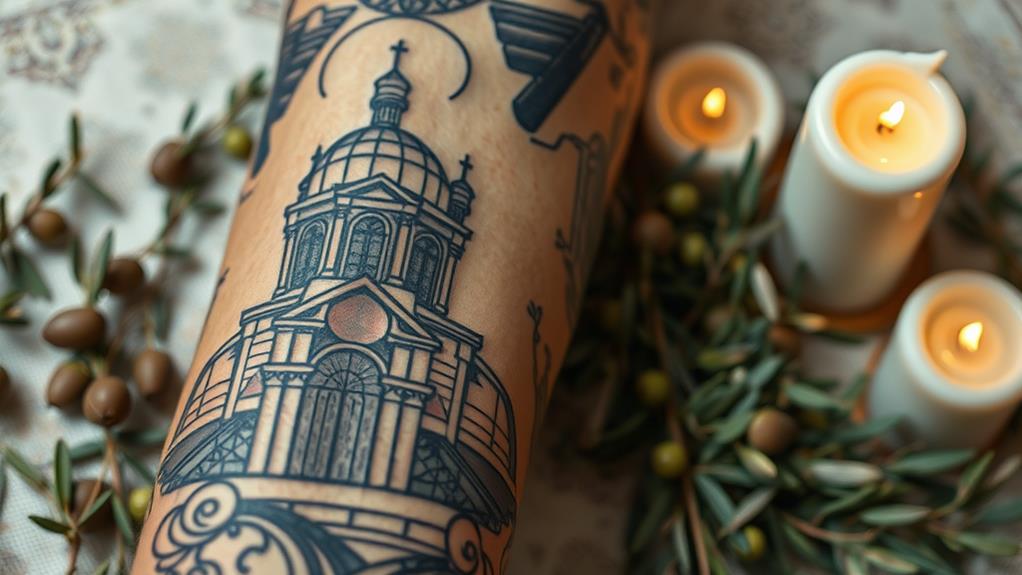
When it comes to the care and maintenance of tattoos, I've found that establishing a daily cleaning routine is vital for preserving their vibrancy.
Moisturizing techniques play a significant role in preventing dryness and fading, while sun protection is essential to safeguard the artwork from UV damage.
Each of these elements contributes to the longevity and appearance of my tattoos, reflecting the importance of proper aftercare.
Daily Cleaning Routine
Maintaining the vibrancy and integrity of Orthodox Church tattoos requires a disciplined daily cleaning routine, essential for preserving both their aesthetic and spiritual significance.
I've found that a gentle yet consistent approach is key. Each morning, I start by washing the tattooed area with lukewarm water and a mild, fragrance-free soap.
This step removes any accumulated dirt and excess oils, which could compromise the tattoo's clarity.
After cleansing, I carefully pat the area dry with a soft towel. I avoid rubbing, as that can irritate the skin and affect the tattoo's appearance.
I then inspect the tattoo for any signs of fading or irritation, which could indicate issues that need addressing.
Throughout the day, I'm mindful of how I interact with the tattoo. I refrain from exposing it to harsh environments or excessive sunlight, as these factors can lead to premature fading.
In the evening, I repeat the cleansing process, ensuring I maintain this ritual consistently.
Moisturizing Techniques
Moisturizing is a crucial aspect of tattoo care, particularly for Orthodox Church tattoos, as it directly impacts their vibrancy and longevity.
I've found that applying a quality moisturizer helps to keep the skin hydrated, preventing the tattoo from fading or developing dry patches that can obscure intricate details.
When I choose a moisturizer, I focus on products that are fragrance-free and formulated specifically for sensitive skin. Ingredients like shea butter and coconut oil have proven effective in maintaining the skin's elasticity and overall health.
I typically apply moisturizer twice a day—once in the morning and once before bed. This routine allows the skin to absorb the product thoroughly, enhancing healing and preserving color.
It's imperative to avoid over-moisturizing, as this can lead to clogged pores or an overly greasy feel.
I also pay attention to the changing seasons; during colder months, I tend to increase the frequency of moisturization to combat dryness.
Sun Protection Tips
In caring for Orthodox Church tattoos, sun protection plays a vital role in preserving their integrity and appearance.
I've learned that ultraviolet (UV) rays can greatly diminish the vibrancy of the colors and distort the fine details inherent in these sacred designs.
To mitigate this risk, I always apply a broad-spectrum sunscreen with an SPF of at least 30 to my tattoos before heading outdoors. This simple step acts as a barrier against both UVA and UVB rays, which are known for their harmful effects on the skin and ink.
Additionally, I try to avoid direct sunlight during peak hours, typically between 10 a.m. and 4 p.m.
When I do find myself in the sun, wearing protective clothing or seeking shade can be excellent alternatives.
I've also found that reapplying sunscreen every two hours, especially after swimming or sweating, greatly enhances protection.
Personal Stories and Testimonials
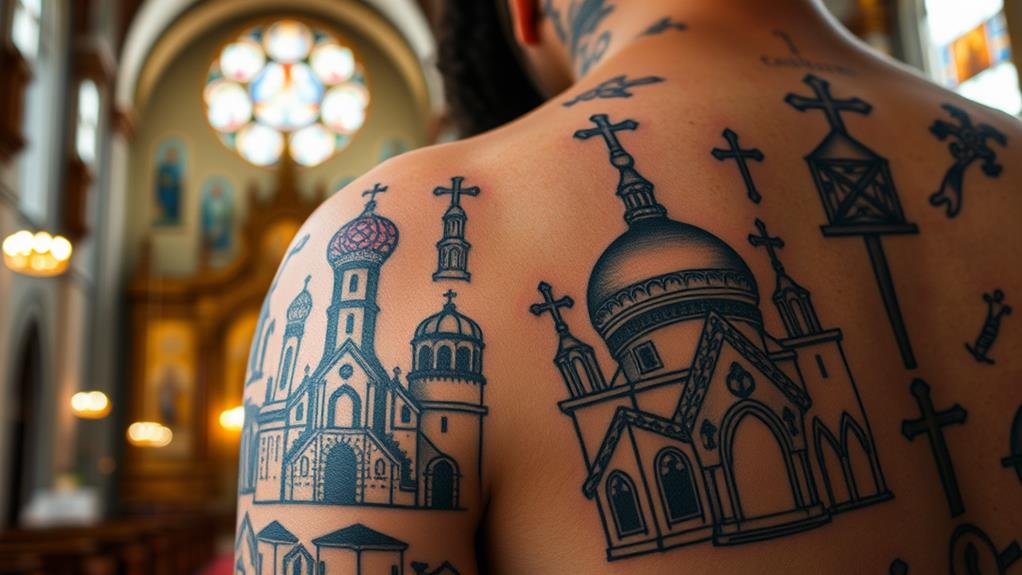
Reflecting on my journey with Orthodox Church tattoos, I've encountered numerous individuals whose stories intertwine personal faith and body art.
Each narrative reveals the profound significance these tattoos hold within their spiritual lives. For many, these designs serve as a declaration to their devotion, acting as visual reminders of their beliefs and commitments.
One individual shared how their tattoo of a specific church steeple symbolizes a pivotal moment in their faith journey, marking a passage from doubt to conviction.
This personal emblem not only reflects their connection to the Orthodox community but also anchors them in their daily life. Another person recounted how their inked iconography, drawn from sacred architecture, serves as a protective talisman, embodying their hope for divine guidance and strength.
These accounts highlight how Orthodox Church tattoos transcend mere aesthetics, becoming integral to their bearers' identities.
They encapsulate a blend of tradition, personal experience, and spiritual expression, revealing that such body art is laden with meaning. Ultimately, these narratives demonstrate the powerful intersection of faith and self-expression, illustrating how tattoos can articulate one's spiritual journey in a deeply personal manner.
Community and Cultural Impact
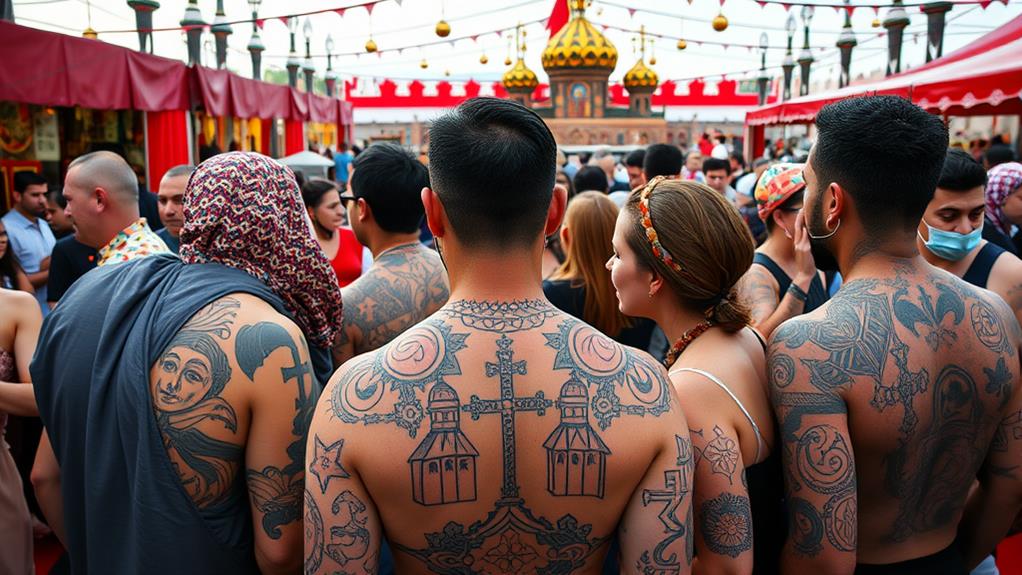
Orthodox Church tattoos have carved out a unique niche within both religious communities and broader cultural contexts.
As I explore their significance, it becomes clear that these tattoos serve not only as personal expressions of faith but also as symbols of cultural identity.
In Orthodox communities, these tattoos often reflect a deep-seated reverence for sacred architecture, embodying spiritual narratives that resonate with believers.
Moreover, within the wider society, they challenge conventional perceptions of body art.
Traditionally, tattoos have been associated with rebellion or nonconformity, yet Orthodox Church tattoos subvert these notions by framing inked imagery as a gateway for spirituality.
This intersection fosters dialogue between faith and modernity, allowing individuals to navigate their religious identities in a contemporary context.
The cultural impact is evident in how these tattoos create spaces for conversation, promoting understanding between diverse groups.
Through shared symbols, they affirm a collective identity that transcends individualism, uniting believers in their sacred heritage.
Consequently, Orthodox Church tattoos emerge not merely as personal adornments but as powerful cultural artifacts that bridge the past and present, shaping community dynamics in profound ways.
Frequently Asked Questions
Are There Specific Colors Associated With Orthodox Church Tattoos?
I've noticed that specific colors often symbolize religious significance. For instance, gold represents divinity, while blue signifies heaven. These colors can enhance the meaning behind tattoos, reflecting deeper spiritual themes within the Orthodox tradition.
Can Orthodox Church Tattoos Be Placed on Any Body Part?
I believe Orthodox church tattoos can be placed on various body parts, reflecting personal significance. However, their placement often depends on individual beliefs and cultural context, which might influence how others perceive these sacred symbols.
Is There a Difference Between Tattoos and Body Art in Orthodoxy?
I believe there's a nuanced distinction between tattoos and body art within Orthodoxy. Tattoos often signify permanence and identity, while body art can be transient, reflecting personal expression rather than a commitment to specific beliefs or traditions.
Are There Any Restrictions for Clergy Regarding Tattoos?
I've found that clergy in the Orthodox Church face specific restrictions regarding tattoos. These guidelines often reflect traditional beliefs about the body's sanctity, emphasizing a commitment to spiritual purity and the church's teachings.
How Do Tattoos Affect One's Standing in the Orthodox Community?
Tattoos can profoundly impact one's standing in the Orthodox community. I've observed that many view them as untraditional, potentially leading to social ostracism or diminished respect, especially among more conservative members who prioritize adherence to religious customs.
